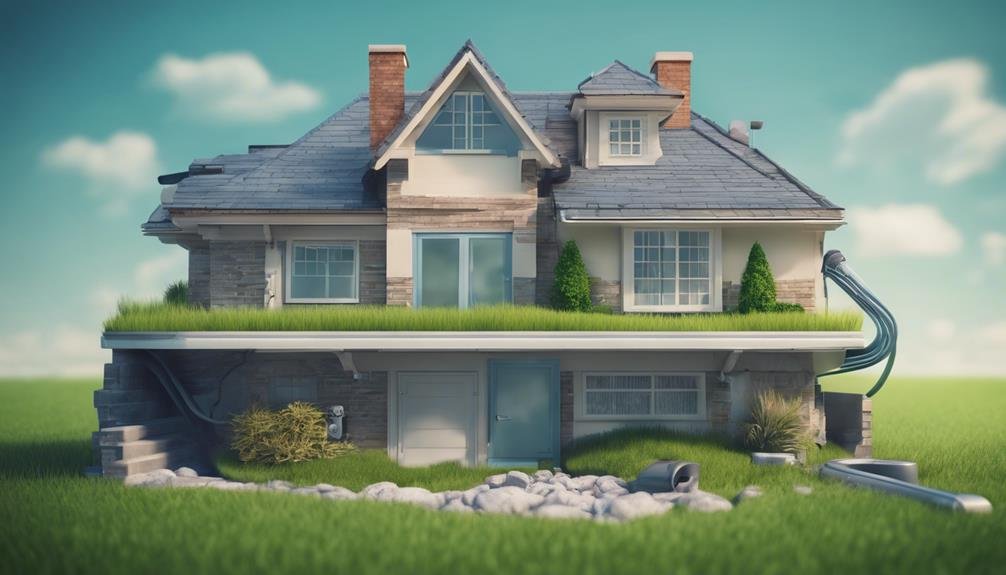For effective home inspection and maintenance, start with the roof. Check shingles for damage and flashing for gaps. Confirm siding is secure and not warped. Review electrical panels for aluminum wiring and double-tapped breakers. Watch for water damage signs like ceiling discoloration or soft floor spots. Regularly inspect HVAC units and water heaters for age and corrosion. Follow a systematic inspection method, documenting findings meticulously. Clear gutters and direct downspouts away from the home to prevent water issues. Don’t overlook spaces like attics for hidden damage. By addressing these areas, you’ll avoid major problems and keep your home in top shape.
Roof and Exterior Assessment

When evaluating your roof and exterior, start by examining the shingles for signs of aging and damage, such as granule loss and brittleness. Check for damaged shingles, especially on roof edges, which often bear the brunt of weather.
Pay attention to improperly installed flashing around the chimney and windows; gaps here can lead to water intrusion. Look for soft spots and signs of leaks, particularly in vulnerable areas.
Inspect the siding for gaps or warping and verify it’s properly fastened. Address drainage issues by observing any ground sloping towards the house, as it can cause water pooling.
Electrical and Wiring Issues
After evaluating the exterior, it’s equally important to examine your electrical and wiring systems to confirm safety and code compliance.
Start by inspecting exposed electrical wiring; if it lacks proper conduit, this is a serious code violation.
Check your electrical panels for aluminum wiring; it needs special attention due to potential hazards.
Look out for corrosion and rust in panel boxes as these indicate more significant issues.
Double tapped breakers are another red flag; they shouldn’t be installed this way.
Verify all screws and nails in brackets are intact to maintain structural integrity.
Finally, note any shifting top plates and require adherence to proper fastening methods to uphold safety standards.
Don’t overlook these crucial checks; your home’s safety depends on them.
Signs of Water Damage

You’ll want to keep an eye out for signs of water damage, as catching these issues early can save you from costly repairs down the line.
Check for discoloration on walls and ceilings, which often indicates moisture issues. Soft spots on floors or around windows are also red flags.
Look closely at the roof and siding; damaged or missing shingles and gaps can let water in. Use a moisture meter to identify hidden dampness, especially if you notice a musty smell, which often signals mold.
Pay attention to the attic and basement—these areas are prone to leaks and moisture buildup. Regular monitoring can help you address small problems before they become major issues.
HVAC and Water Heaters
As you address potential water damage, take some time to evaluate the functionality and age of your HVAC system and water heater.
Check your HVAC unit’s manufacture date; if it’s from 2006 or earlier, it probably uses R22 refrigerant, which is phased out. An upgrade might be necessary. Regular maintenance extends its life, so don’t skip those check-ups.
Your water heater from 2006 is also near its end. Look for corrosion at connections, especially where dissimilar metals meet, as this speeds up deterioration. Confirm there’s a manual disconnect for safety.
Inform clients about potential replacement costs for both systems. Staying proactive with HVAC and water heater inspections can prevent bigger issues down the road.
Inspection Best Practices
Inspecting a home thoroughly requires adherence to best practices that guarantee nothing is overlooked, ultimately safeguarding both current and future homeowners.
Start with a methodical approach—begin outside and work inwards, making certain every section is covered. Document all findings with photos and detailed notes; this provides clarity for both you and the homeowner.
Always check behind appliances, in attics, and crawl spaces for hidden damage or safety concerns. Keep an eye out for water intrusion signs, like soft spots or discoloration.
Never leave rooms with running water unattended to prevent flooding. Use moisture meters and electrical testers to identify issues accurately.
Consistently updating your knowledge on building codes and inspection techniques guarantees you provide the best service possible.
Common Mistakes
Many home inspectors make the mistake of not thoroughly examining attic spaces, often leading to missed issues that could become costly for homeowners. Ensuring you inspect attics can reveal hidden water damage, inadequate insulation, and pest infestations.
You should also carefully check electrical wiring for signs of wear or outdated materials. Another common mistake is overlooking the condition of HVAC systems and water heaters. Don’t ignore the manufacturing date or signs of wear and corrosion.
It’s vital to remember that safety standards, such as proper ductwork support and stairwell safety, are easily missed but essential.
Drainage and Water Control

Effective drainage and water control prevent water damage and costly repairs for homeowners.
First, make certain your gutters and downspouts are clear of debris. Clogged gutters can overflow and cause water to seep into your foundation.
Check your downspouts to guarantee they direct water away from the house, preferably at least six feet.
Grade the soil around your home so that it slopes away, encouraging water to drain properly. Avoid allowing water to pool near your foundation, as it can lead to structural issues.
Consider installing a French drain or sump pump if your yard has persistent drainage problems.
Regular inspections can help you spot issues early and mitigate potential damage.
Conclusion
In short, conducting a thorough home inspection isn’t just wise—it’s essential.
For instance, catching brittle shingles early can save you from dealing with costly leaks later.
Always scrutinize for hidden water damage with moisture meters, as unseen leaks can compromise structural integrity.
Stay vigilant about electrical issues; even minor violations can pose serious hazards.
By adopting these best practices and avoiding common mistakes, you’re ensuring your home stays safe, functional, and valuable.


















